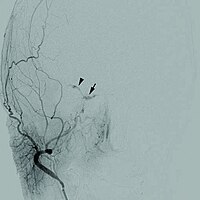
Photo from wikipedia
Introduction Pediatric moyamoya disease induces more frequent and serious cerebral ischemia/infarction after anastomosis surgery, leading to permanent disability. Although younger age, neurological severity, and unfavorable hemodynamics, preoperatively, are known to… Click to show full abstract
Introduction Pediatric moyamoya disease induces more frequent and serious cerebral ischemia/infarction after anastomosis surgery, leading to permanent disability. Although younger age, neurological severity, and unfavorable hemodynamics, preoperatively, are known to associate with postoperative adverse events, prediction of postoperative complications is still clinically demanding. This study aimed to investigate predictive value of intraoperative electroencephalography (EEG) during indirect revascularization (encephaloduroarteriosynangiosis) for post-operative transient ischemic attack (TIA) or infarction in pediatric moyamoya disease. Methods We retrospectively reviewed clinical records and intraoperative EEG of consecutively sampled 41 patients from a university hospital diagnosed as pediatric moyamoya disease. EEG was recorded in 3 channels. Power spectrum analysis provided absolute power of alpha wave (P_alpha). Preoperative infarction, hemodynamic status from perfusion MRI, age, and postoperative outcomes were used as clinical variables. Logistic regression analysis was performed to predict postoperative ischemia/infarction using P_alpha and clinical variables. Results Mean age of study population was 7.76 ± 5.12 (years old). Out of 41 patients, 26 patients (63.4%) did not experience infarction before operation. Correlation was shown between age and preoperative infarction ( p = 0.020). Postoperative outcomes were no TIA in 14 (34.1%), mild TIA without infarction in 18 (43.9%), and heavy TIA or infarction in 8 (22%) patients. Preoperative infarction, hemodynamic parameters in perfusion MRI, or age did not correlate with postoperative outcomes in univariate analyses. P_alpha showed strong correlation with postoperative outcome ( p = 0.014), especially in cases without preoperative infarction ( p = 0.034). Multivariate logistic regression analysis revealed that preoperative infarction and P_alpha together showed strong predictive value for postoperative outcome ( p = 0.008 for P_alpha, p = 0.072 for preoperative infarction). Conclusion Power of alpha wave during anastomosis in pediatric moyamoya disease shows strong predictive value for postoperative outcomes, especially for patients without preoperative infarction. Intraoperative EEG monitoring can be advantageous to improve postoperative care in children with moyamoya disease.
Journal Title: Clinical Neurophysiology
Year Published: 2018
Link to full text (if available)
Share on Social Media: Sign Up to like & get
recommendations!